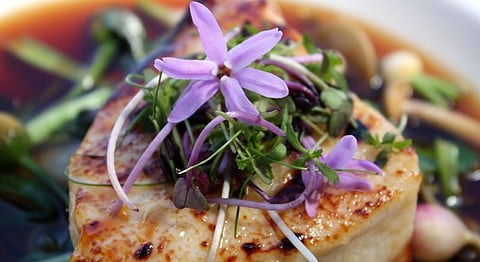
- HOMEGROWN WORLD
- #HGCREATORS
- #HGEXPLORE
- #HGVOICES
- #HGSHOP
- CAREERS
- ABOUT US
- CONTACT US

The moment of truth. You eye your waiter as he emerges from the kitchen, you’ve had a few false starts already but this time it’s really happening. You’ve done your waiting, half an hour of it, in this frozen wasteland of a restaurant all the time nibbling politely on breadsticks and sipping your wine. But finally you’re about to cash in and as you anticipate the grand reveal; in your head you review the description of your dish. “A cut of the finest beef, served rare with a red wine and mushroom jus, sautéed vegetables and mashed potatoes”. A hearty, solid choice by all accounts, ‘meat and two veg’ the perfect comfort food to cushion a bad week, what could possibly go wrong? But then as your plate is deposited before you, you realised how terribly, horribly, catastrophically wrong you were. Three fingers of lean meat lying atop artistic smears of white and burgundy, a lone baby carrot clings to its asparagus spear companions huddled sadly in this desolate expanse of plate. And to add insult to injury, little bursts of colour wink up cheerfully, almost gleefully in the form of edible – and as it transpires, tasteless – flowers. Excuse me. Why. Are. There. Flowers. In. My. Food?
So begins the great and mysterious journey of plating.
Though sometimes infuriating, especially if you’re in the throes of unquenchable ‘hanger’, plating can actually make or break a dish. The visual appeal of food is a huge factor in the cognitive process of enjoyment and even if something tastes stupendous, if it looks like something out of a pig trough, chances are you won’t be able to fully enjoy it (with the curious exception of late night ‘Chindian’ food). Over the years, top chefs have facilitated a veritable revolution of plating whether it was the more homely ‘rule of threes’ in the 1970s, the wabi-sabi influenced minimalism of the 1990s right up to today’s penchant for deconstruction and molecular gastronomy – where you run the risk of being served a cup of flavoured foam in lieu of a meal.
The plating choice for a dish leans heavily on the ingredients, where the colour, contrast and use of space are key. Think of it as interior design for the gourmand. The type of cuisine of course dictates the possibilities, as anyone trying to elegantly drape spaghetti will assure you, and with the globalisation of food, plating has spiralled through so many forms that it’s an art form unto itself. One of the most iconic stories in fine-dining today is that of Massimo Bottura’s dessert quite fittingly dubbed ‘Oops, I dropped the lemon tart.’ As the story goes, one of the chefs at his restaurant Osteria Francescana in Modena accidentally (you guessed it) dropped the lemon tart. Looking at the smashed remains, Massimo chose to piece them back together in a testament to its incongruous perfection, “This dessert pokes fun at our daily striving for perfection and pristine beauty,” says Massimo and in doing so he made history by proving that even anti-plating is in fact plating.
You might argue that in the majority of Indian restaurants, plating doesn’t hold much sway since a bowl of curry ostensibly looks like every other bowl of curry, but then came the new wave of Indian chefs and with them a revolution. Chefs like Gaggan Anand and Vineet Bhatia brought Modern Indian cuisine into the limelight, they highlighted non-traditional (but very much indigenous) ingredients and proved that Indian cuisine was more than the world had ever dreamed was possible and more importantly, they made it look beautiful. There’s something to be said for deconstruction of a dish, though tedious to eat, it introduces a new component of discovery to the process, where you can enjoy each element individually or let it shine as a whole, a feat that Indian cuisine hadn’t achieved in the past.
Across on the other side of the world, the New Nordic movement was in full swing, chefs were returning to the concept of localisation and using ingredients that they found –sometimes literally – in their backyards. It was attributed to René Redzepi and the kitchens of Noma and it was with his innovations in the early 2000’s that the molecular gastronomy and technical cooking craze is said to have come to a close. With this return to authenticity, flowers reappeared on plates the world over as a hat-tip to the revival of local produce.
And onwards the merry-go-round spins, trends come and go and what was once deemed ‘rustic’ becomes hipster. Through all the many avatars of plating, we know one thing to be absolutely true, you cannot save a terrible dish with artistic plating and that knowledge keeps us sane. You may deem it unnecessary but next time you make dinner, sprinkle on some fresh herbs, or maybe grate a bit of cheese over it and watch how something so seemingly inconsequential can change the game. If you still don’t feel like you can make your peace with it, remember that we live in world where food that can’t be Instagrammed is deemed hardly worth eating. And that the group at the next table, phones at the ready as their entrees cool, are the culmination of decades of innovation and technique.
